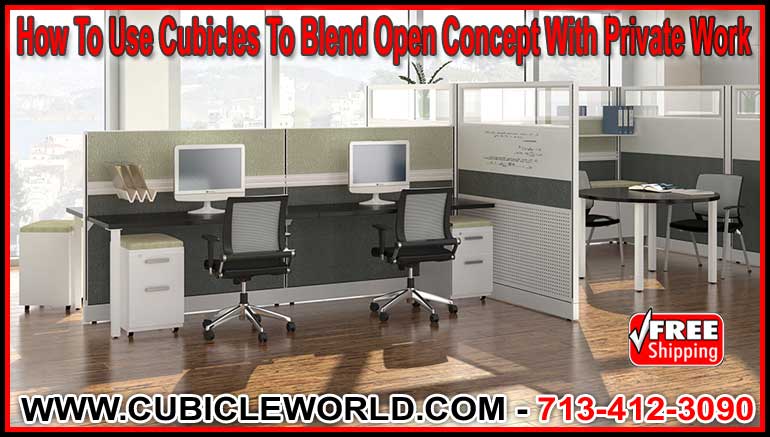
Open concept cubicles are a perfect middle ground between the open-plan office and the private cubicle. Open-plan offices have been a relatively new concept that many companies have adopted. This kind of office features a large, singular space shared by all employees with no physical separation between them. Many have praised open-plan offices for their ability to facilitate collaboration and a sense of transparency and fairness. Some also believe them to offer an economic advantage by foregoing the cost of providing partitions and maximizing office space. However, open-plan offices may be costlier than first thought, and for as much as they follow the current trend of breaking down boundaries at the workplace, later studies have shown just how important some boundaries can be.
This is where the open concept cubicle comes into play. Open concept cubicles are a lot like traditional cubicles, only they are designed specifically to negotiate the positives and negatives of an open-plan office space. Multiple circumstances in an open-plan setting paint a strong picture of how decreased privacy actually contributes to decreased productivity. In one study, employees said that lack of privacy from both sound (for almost 50% of employees) and visual (over 30%) was a major complaint. Being forced into close proximity with other coworkers can lead to feelings of discomfort and take a toll on worker concentration. Operating within a shared space can increase feelings of vulnerability also. Other distractions often include loud coworkers, music from personal work areas, and off-topic discussion with neighbors. Open concept cubicles encourage collaboration and interaction between coworkers without leading to the negative effects that a lack of privacy has on their ability to stay on task.
The main way that open concept cubicles maintain interactivity and privacy is through the strategic use of their partitions. In the case of a two-workstation unit, you’d likely see relatively high perimeter walls, just like any standard personal cubicle. A lower partition, if any, separates the workstations from each other and can vary in height depending on privacy needs. This is more ideal than having no partition between workstations since employees don’t typically like their paperwork and computer screens to be on display.
The material of your partitions is also a big factor in keeping a sense of privacy in your open concept cubicle, both visually and sound-wise. The soft, absorbent qualities of fabric make it a great option for keeping sounds from carrying from one space to the next in a large office space where reflected sound can be common. The harder the surface, such as glass or metal, the more sound will reflect. Fabric may be your best way to go for external wall panels. As far as visual privacy, many types of material can suit your needs. Unless the simple inclusion of the partition itself is a way to evoke a sense of privacy, it would be good to avoid clear glass. Frosted or translucent glass helps you to maintain a sense of privacy while allowing natural or mechanical lighting to come through to your work surface.
The open concept cubicle pictured above shows how creative you can get in designing an interactive but partition-based workstation for your office. You can see that there’s a partition separating the two workstations from the conference space, while the spaces still cluster together as a cohesive unit. The inclusion of a whiteboard and a glass panel in the partition shows how the partition’s being used simultaneously as a tool for separation and as a tool for creative collaboration. This is the essence of the open concept cubicle.
Open concept cubicles can be useful by any number of companies, especially those that have creative teams or research teams that share data and information among each other. Small design and engineering firms, advertising and marketing agencies, and business cooperatives are good examples of organizations that break into task-based groups to brainstorm and discuss ideas creatively in order to contribute to the project as a whole. Contact us today.
Open Concept Cubicles – FREE Quote 713-412-3090
